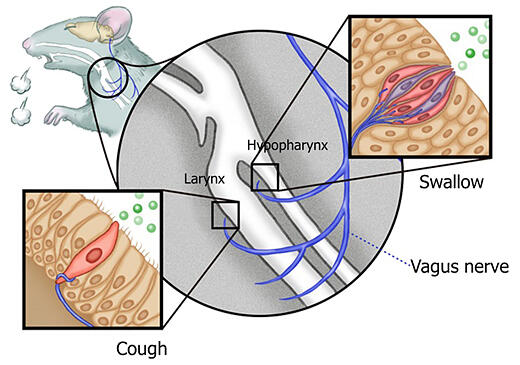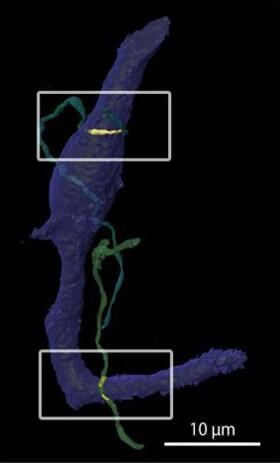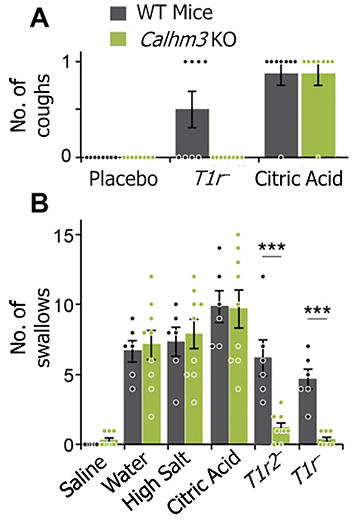A research group from Kyoto Prefectural University of Medicine and other institutions has discovered a new sensory organ in the throat of mice that triggers coughing and swallowing in response to bitter substances and other stimuli. Coughing occurs in the larynx, which is at the entrance to the trachea, while swallowing occurs in the hypopharynx, which connects to the esophagus. This discovery not only has the potential to contribute to the development of treatments for chronic cough but may also provide the key to understanding the scientifically unclear mechanism of beer "smoothness" (nodogoshi in Japanese - the tactile sensation in the throat as it is swallowed).

Provided by Professor Akiyuki Taruno of Kyoto Prefectural University of Medicine
When it comes to the mechanism of information transmission that occurs in nerve cells before sensations are conveyed to the brain, "synapses" are well known, where chemical substances such as dopamine, GABA (gamma-aminobutyric acid), and acetylcholine that are wrapped in vesicles within cells are released when the vesicles open upon contact with the cell membrane, enabling information transmission.
Around 2013, Professor Akiyuki Taruno, who studies physiology at the Graduate School of Medical Science at Kyoto Prefectural University of Medicine, discovered a synaptic mode different from vesicles called "channel synapses," where information transmission to nerve cells occurs through the opening of membrane proteins with pores called channels, allowing chemical substances to exit. He clarified that these channel synapses facilitate information communication between epithelial cells and nerve cells and are involved in the mechanism that senses saltiness in taste buds on the tongue and transmits this information to the brain.
Since it was unknown where the new channel synapses functioned, Taruno and his colleagues examined 44 organs and tissues in mice to see if genes for the relevant channels were active and obtained results suggesting that channel synapses were abundant in the throat. Upon detailed examination of the throat, they found new sensory organs with channel synapses on the surface (epithelium) of both the larynx, which connects to the airway leading to the lungs, and the hypopharynx, which connects to the esophagus leading to the stomach. These sensory organs could be classified into "tuft cells" that extend brush-like microvilli to detect chemical substances, and "type 2 taste cells" found within taste buds.

Provided by Professor Akiyuki Taruno of Kyoto Prefectural University of Medicine
After genetic analysis, the researchers used mice in which channel synapses were rendered non-functional to investigate the function of the sensory organs and found that they respond to numerous harmful chemical substances including plant extracts containing bitter toxins, tobacco smoke, air pollutants, and pathogen-related substances. They also discovered the mechanism by which, upon reaction, adenosine triphosphate (ATP) is released from channel synapses to activate the vagus nerve. Laryngeal tuft cells promoted coughing, while pharyngeal type 2 taste cells promoted swallowing. While bitter substances in taste buds on the tongue trigger a desire to spit out, in the hypopharynx they conversely promote a reflex toward swallowing.

Provided by Professor Akiyuki Taruno of Kyoto Prefectural University of Medicine
There are estimates that approximately 10% of the world's population suffers from chronic cough, but in many cases the cause is unknown and difficult to treat, with available medications limited to those with non-negligible side effects. If chronic cough caused by the newly discovered laryngeal tuft cells can be identified, it would open a path for treatment through drug development targeting molecules within tuft cells.
Regarding swallowing, it was found that bitter substances that make you want to spit them out when tasted on the tongue actually promote swallowing in the hypopharynx. This could potentially provide a scientific explanation for the good "smoothness" that allows people to gulp down bitter beer. Taruno said, "The expression on a person's face after enjoyably drinking bitter beer is different from the smile after eating something sweet. Pharyngeal type 2 taste cells with channel synapses might be the sensory sensors responsible for throat feel."
This research was conducted in collaboration with RIKEN and other institutions, with support from the Japan Science and Technology Agency (JST) Strategic Basic Research Programs, Japan Society for the Promotion of Science Grants-in-Aid for Scientific Research, Salt Science Research Foundation, Naito Foundation, Takeda Science Foundation, Urakami Foundation for Food and Food Culture Promotion, and the Japan Agency for Medical Research and Development (AMED). The research results were published in the electronic edition of the American scientific journal Cell on April 5.
Original article was provided by the Science Portal and has been translated by Science Japan.




